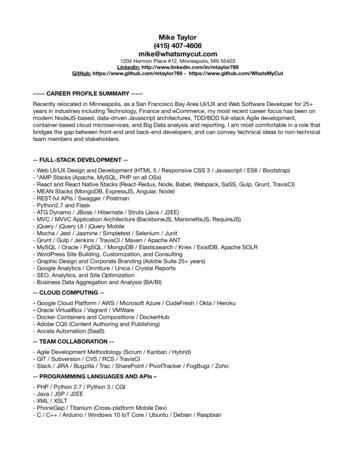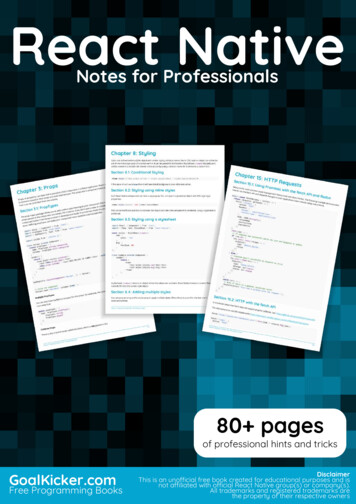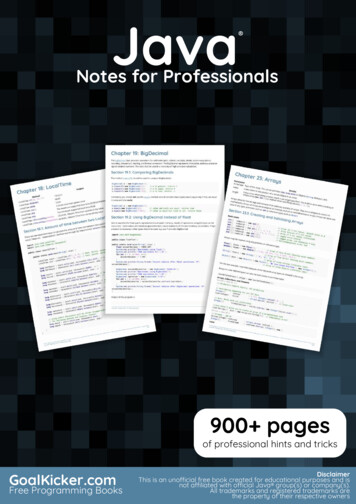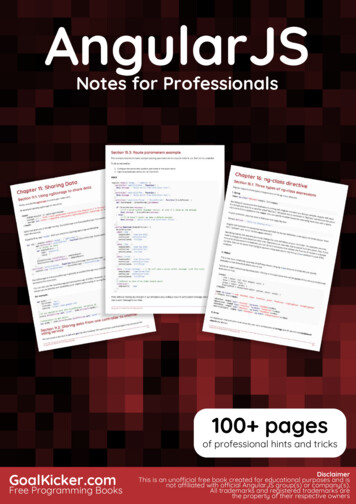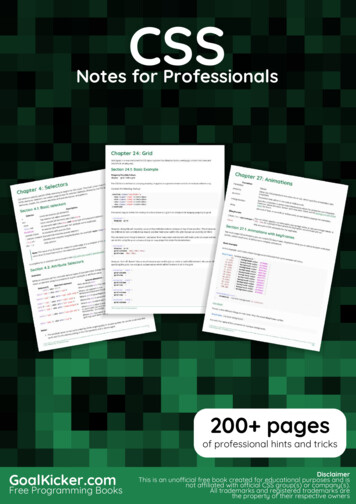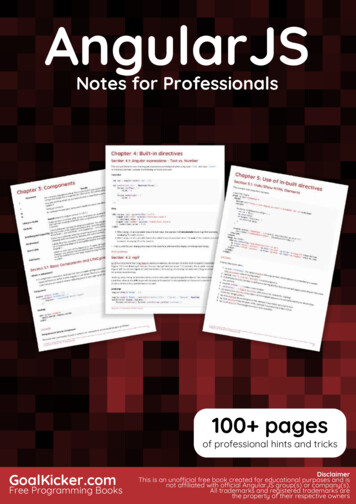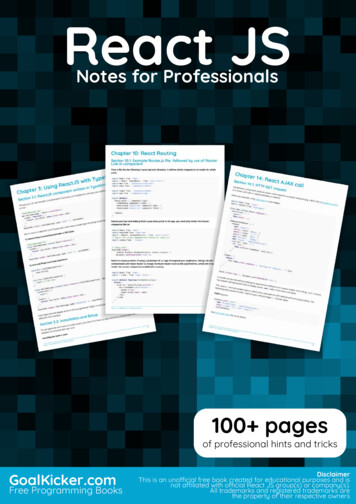
Transcription
React JSReact JSNotes for ProfessionalsNotes for Professionals100 pagesof professional hints and tricksGoalKicker.comFree Programming BooksDisclaimerThis is an uno cial free book created for educational purposes and isnot a liated with o cial React JS group(s) or company(s).All trademarks and registered trademarks arethe property of their respective owners
ContentsAbout . 1Chapter 1: Getting started with React . 2Section 1.1: What is ReactJS? . 2Section 1.2: Installation or Setup . 3Section 1.3: Hello World with Stateless Functions . 4Section 1.4: Absolute Basics of Creating Reusable Components . 5Section 1.5: Create React App . 6Section 1.6: Hello World . 7Section 1.7: Hello World Component . 8Chapter 2: Components . 11Section 2.1: Creating Components . 11Section 2.2: Basic Component . 13Section 2.3: Nesting Components . 14Section 2.4: Props . 16Section 2.5: Component states - Dynamic user-interface . 17Section 2.6: Variations of Stateless Functional Components . 19Section 2.7: setState pitfalls . 20Chapter 3: Using ReactJS with TypeScript . 22Section 3.1: ReactJS component written in TypeScript . 22Section 3.2: Installation and Setup . 22Section 3.3: Stateless React Components in TypeScript . 23Section 3.4: Stateless and property-less Components . 24Chapter 4: State in React . 25Section 4.1: Basic State . 25Section 4.2: Common Antipattern . 25Section 4.3: setState() . 26Section 4.4: State, Events And Managed Controls . 28Chapter 5: Props in React . 30Section 5.1: Introduction . 30Section 5.2: Default props . 30Section 5.3: PropTypes . 31Section 5.4: Passing down props using spread operator . 32Section 5.5: Props.children and component composition . 33Section 5.6: Detecting the type of Children components . 34Chapter 6: React Component Lifecycle . 35Section 6.1: Component Creation . 35Section 6.2: Component Removal . 37Section 6.3: Component Update . 38Section 6.4: Lifecycle method call in di erent states . 39Section 6.5: React Component Container . 40Chapter 7: Forms and User Input . 42Section 7.1: Controlled Components . 42Section 7.2: Uncontrolled Components . 42Chapter 8: React Boilerplate [React Babel Webpack] . 44Section 8.1: react-starter project . 44Section 8.2: Setting up the project . 45
Chapter 9: Using ReactJS with jQuery . 48Section 9.1: ReactJS with jQuery . 48Chapter 10: React Routing . 50Section 10.1: Example Routes.js file, followed by use of Router Link in component . 50Section 10.2: React Routing Async . 51Chapter 11: Communicate Between Components . 52Section 11.1: Communication between Stateless Functional Components . 52Chapter 12: How to setup a basic webpack, react and babel environment . 54Section 12.1: How to build a pipeline for a customized "Hello world" with images . 54Chapter 13: React.createClass vs extends React.Component . 58Section 13.1: Create React Component . 58Section 13.2: "this" Context . 58Section 13.3: Declare Default Props and PropTypes . 60Section 13.4: Mixins . 62Section 13.5: Set Initial State . 62Section 13.6: ES6/React “this” keyword with ajax to get data from server . 63Chapter 14: React AJAX call . 65Section 14.1: HTTP GET request . 65Section 14.2: HTTP GET request and looping through data . 66Section 14.3: Ajax in React without a third party library - a.k.a with VanillaJS . 66Chapter 15: Communication Between Components . 68Section 15.1: Child to Parent Components . 68Section 15.2: Not-related Components . 68Section 15.3: Parent to Child Components . 69Chapter 16: Stateless Functional Components . 71Section 16.1: Stateless Functional Component . 71Chapter 17: Performance . 74Section 17.1: Performance measurement with ReactJS . 74Section 17.2: React's di algorithm . 74Section 17.3: The Basics - HTML DOM vs Virtual DOM . 75Section 17.4: Tips & Tricks . 76Chapter 18: Introduction to Server-Side Rendering . 77Section 18.1: Rendering components . 77Chapter 19: Setting Up React Environment . 78Section 19.1: Simple React Component . 78Section 19.2: Install all dependencies . 78Section 19.3: Configure webpack . 78Section 19.4: Configure babel . 79Section 19.5: HTML file to use react component . 79Section 19.6: Transpile and bundle your component . 79Chapter 20: Using React with Flow . 80Section 20.1: Using Flow to check prop types of stateless functional components . 80Section 20.2: Using Flow to check prop types . 80Chapter 21: JSX . 81Section 21.1: Props in JSX . 81Section 21.2: Children in JSX . 82Chapter 22: React Forms . 85Section 22.1: Controlled Components . 85
Chapter 23: User interface solutions . 87Section 23.1: Basic Pane . 87Section 23.2: Panel . 87Section 23.3: Tab . 88Section 23.4: PanelGroup . 88Section 23.5: Example view with PanelGroup s . 89Chapter 24: Using ReactJS in Flux way . 91Section 24.1: Data Flow . 91Chapter 25: React, Webpack & TypeScript installation . 92Section 25.1: webpack.config.js . 92Section 25.2: tsconfig.json . 92Section 25.3: My First Component . 93Chapter 26: How and why to use keys in React . 94Section 26.1: Basic Example . 94Chapter 27: Keys in react . 95Section 27.1: Using the id of an element . 95Section 27.2: Using the array index . 95Chapter 28: Higher Order Components . 97Section 28.1: Higher Order Component that checks for authentication . 97Section 28.2: Simple Higher Order Component . 98Chapter 29: React with Redux . 99Section 29.1: Using Connect . 99Appendix A: Installation . 100Section A.1: Simple setup . 100Section A.2: Using webpack-dev-server . 101Appendix B: React Tools . 103Section B.1: Links . 103Credits . 104You may also like . 106
AboutPlease feel free to share this PDF with anyone for free,latest version of this book can be downloaded from:https://goalkicker.com/ReactJSBookThis React JS Notes for Professionals book is compiled from Stack OverflowDocumentation, the content is written by the beautiful people at Stack Overflow.Text content is released under Creative Commons BY-SA, see credits at the endof this book whom contributed to the various chapters. Images may be copyrightof their respective owners unless otherwise specifiedThis is an unofficial free book created for educational purposes and is notaffiliated with official React JS group(s) or company(s) nor Stack Overflow. Alltrademarks and registered trademarks are the property of their respectivecompany ownersThe information presented in this book is not guaranteed to be correct noraccurate, use at your own riskPlease send feedback and corrections to web@petercv.comGoalKicker.com – React JS Notes for Professionals1
Chapter 1: Getting started with ReactVersion Release 3.12018-04-0316.3.22018-04-16Section 1.1: What is ReactJS?ReactJS is an open-source, component based front end library responsible only for the view layer of theapplication. It is maintained by Facebook.ReactJS uses virtual DOM based mechanism to fill in data (views) in HTML DOM. The virtual DOM works fast owningto the fact that it only changes individual DOM elements instead of reloading complete DOM every timeA React application is made up of multiple components, each responsible for outputting a small,reusable piece of HTML. Components can be nested within other components to allow complexapplications to be built out of simple building blocks. A component may also maintain internal state - forexample, a TabList component may store a variable corresponding to the currently open tab.GoalKicker.com – React JS Notes for Professionals2
React allows us to write components using a domain-specific language called JSX. JSX allows us to write ourcomponents using HTML, whilst mixing in JavaScript events. React will internally convert this into a virtual DOM, andwill ultimately output our HTML for us.React "reacts" to state changes in your components quickly and automatically to rerender the components in theHTML DOM by utilizing the virtual DOM. The virtual DOM is an in-memory representation of an actual DOM. Bydoing most of the processing inside the virtual DOM rather than directly in the browser's DOM, React can actquickly and only add, update, and remove components which have changed since the last render cycle occurred.Section 1.2: Installation or SetupReactJS is a JavaScript library contained in a single file react- version .js that can be included in any HTML page.People also commonly install the React DOM library react-dom- version .js along with the main React file:Basic Inclusion !DOCTYPE html html head /head body script type "text/javascript" src "/path/to/react.js" /script script type "text/javascript" src "/path/to/react-dom.js" /script script type "text/javascript" // Use react JavaScript code here or in a separate file /script /body /html To get the JavaScript files, go to the installation page of the official React documentation.React also supports JSX syntax. JSX is an extension created by Facebook that adds XML syntax to JavaScript. In orderto use JSX you need to include the Babel library and change script type "text/javascript" to scripttype "text/babel" in order to translate JSX to Javascript code. !DOCTYPE html html head /head body script type "text/javascript" src "/path/to/react.js" /script script type "text/javascript" src "/path/to/react-dom.js" /script script src js" /script script type "text/babel" // Use react JSX code here or in a separate file /script /body /html Installing via npmYou can also install React using npm by doing the following:npm install --save react react-domTo use React in your JavaScript project, you can do the following:var React require('react');var ReactDOM require('react-dom');GoalKicker.com – React JS Notes for Professionals3
ReactDOM.render( App / , .);Installing via YarnFacebook released its own package manager named Yarn, which can also be used to install React. After installingYarn you just need to run this command:yarn add react react-domYou can then use React in your project in exactly the same way as if you had installed React via npm.Section 1.3: Hello World with Stateless FunctionsStateless components are getting their philosophy from functional programming. Which implies that: A functionreturns all time the same thing exactly on what is given to it.For example:const statelessSum (a, b) a b;let a 0;const statefulSum () a ;As you can see from the above example that, statelessSum is always will return the same values given a and b.However, statefulSum function will not return the same values given even no parameters. This type of function'sbehaviour is also called as a side-effect. Since, the component affects somethings beyond.So, it is advised to use stateless components more often, since they are side-effect free and will create the samebehaviour always. That is what you want to be after in your apps because fluctuating state is the worst casescenario for a maintainable program.The most basic type of react component is one without state. React components that are pure functions of theirprops and do not require any internal state management can be written as simple JavaScript functions. These aresaid to be Stateless Functional Components because they are a function only of props, without having any stateto keep track of.Here is a simple example to illustrate the concept of a Stateless Functional Component:// In HTML div id "element" /div // In Reactconst MyComponent props {return h1 Hello, {props.name}! /h1 ;};ReactDOM.render( MyComponent name "Arun" / , element);// Will render h1 Hello, Arun! /h1 Note that all that this component does is render an h1 element containing the name prop. This component doesn'tkeep track of any state. Here's an ES6 example as well:import React from 'react'const HelloWorld props ( h1 Hello, {props.name}! /h1 )GoalKicker.com – React JS Notes for Professionals4
HelloWorld.propTypes {name: React.PropTypes.string.isRequired}export default HelloWorldSince these components do not require a backing instance to manage the state, React has more room foroptimizations. The implementation is clean, but as of yet no such optimizations for stateless components havebeen implemented.Section 1.4: Absolute Basics of Creating ReusableComponentsComponents and PropsAs React concerns itself only with an application's view, the bulk of development in React will be the creation ofcomponents. A component represents a portion of the view of your application. "Props" are simply the attributesused on a JSX node (e.g. SomeComponent someProp "some prop's value" / ), and are the primary way ourapplication interacts with our components. In the snippet above, inside of SomeComponent, we would have accessto this.props, whose value would be the object {someProp: "some prop's value"}.It can be useful to think of React components as simple functions - they take input in the form of "props", andproduce output as markup. Many simple components take this a step further, making themselves "Pure Functions",meaning they do not issue side effects, and are idempotent (given a set of inputs, the component will alwaysproduce the same output). This goal can be formally enforced by actually creating components as functions, ratherthan "classes". There are three ways of creating a React component:Functional ("Stateless") Componentsconst FirstComponent props ( div {props.content} /div );React.createClass()const SecondComponent React.createClass({render: function () {return ( div {this.props.content} /div );}});ES2015 Classesclass ThirdComponent extends React.Component {render() {return ( div {this.props.content} /div );}}These components are used in exactly the same way:const ParentComponent function (props) {const someText "FooBar";GoalKicker.com – React JS Notes for Professionals5
return ( FirstComponent content {someText} / SecondComponent content {someText} / ThirdComponent content {someText} / );}The above examples will all produce identical markup.Functional components cannot have "state" within them. So if your component needs to have a state, then go forclass based components. Refer Creating Components for more information.As a final note, react props are immutable once they have been passed in, meaning they cannot be modified fromwithin a component. If the parent of a component changes the value of a prop, React handles replacing the oldprops with the new, the component will rerender itself using the new values.See Thinking In React and Reusable Components for deeper dives into the relationship of props to components.Section 1.5: Create React Appcreate-react-app is a React app boilerplate generator created by Facebook. It provides a development environmentconfigured for ease-of-use with minimal setup, including:ES6 and JSX transpilationDev server with hot module reloadingCode lintingCSS auto-prefixingBuild script with JS, CSS and image bundling, and sourcemapsJest testing frameworkInstallationFirst, install create-react-app globally with node package manager (npm).npm install -g create-react-appThen run the generator in your chosen directory.create-react-app my-appNavigate to the newly created directory and run the start script.cd my-app/npm startConfigurationcreate-react-app is intentionally non-configurable by default. If non-default usage is required, for example, to use acompiled CSS language such as Sass, then the eject command can be used.npm run ejectThis allows editing of all configuration files. N.B. this is an irreversible process.AlternativesGoalKicker.com – React JS Notes for Professionals6
Alternative
Free Programming Books Disclaimer This is an uno cial free book created for educational purposes and is not a liated with o cial React JS group(s) or company(s). All trademarks and registered trad


